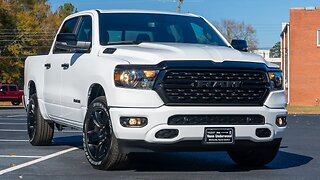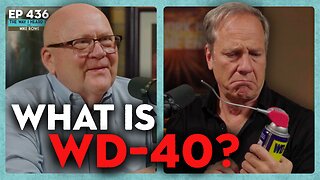Premium Only Content

🕷️ Intro to Spyderco Knives For Beginners
Spyderco was founded in 1976 by Sal and Gail Glesser. In 1978, they settled in Golden, Colorado, and initially, the company focused on selling our first product: the Tri-Angle Sharpmaker™ which was primarily sold at fairs and trade shows around the country. In 1981, Spyderco introduced their first folding knife, the C01 Worker. That knife pioneered the concept of a round hole in the blade for one-handed opening, a clip on the handle for carry at the top of the pocket, and the option of a serrated edge for aggressive cutting performance. Those features revolutionized the knife industry and literally defined the form of the modern folding knife. https://www.spyderco.com/
Blade Steel Info: https://www.bladehq.com/blog/knife-steel-guide/
@BladeHQ
When describing the characteristics of a steel, a few common attributes are commonly talked about. Each of these contributes to a knife’s overall performance. Here, we will discuss edge retention, toughness, ease of sharpening, and corrosion resistance.
Edge Retention
Edge retention often refers to the ability of a knife’s edge to maintain its sharpness during use. However, it can be somewhat complicated because an edge can dull from many causes – wear, micro-chipping, deformation, or corrosion. Most edge retention tests isolate wear resistance or how long it takes abrasives to dull your edge in whatever you’re cutting. Wear resistance comes from hardness and carbides, hard particles formed between carbon and another element like Vanadium or Tungsten.
Toughness
Toughness is the resistance to chipping or breaking. Tough steel can handle impacts without gross chipping or a tip breaking off. Steels that are higher in hardness and wear resistance are usually lower in toughness. This is one of the fundamental tradeoffs in steel. Steels that can be high in edge retention and toughness are desirable for general use knives. Steels high in toughness are excellent for knives likely to see hard impacts, like large chopping knives.
Corrosion Resistance
Corrosion on knife steels most usually takes the form of rust, patina, and staining. Corrosion is not only cosmetic. It can dull your edge, cause pitting, and damage the structural integrity of your knife. Stainless steels are more resistant to corrosion but remember that stainless steels stain less, and most of them will still rust in the right conditions. Being stainless is not an on or off property, and some stainless steels are more resistant to corrosion than others.
Ease of Sharpening
Ease of sharpening refers to how difficult it is to remove material with a sharpening stone. Wear resistance, be it high or low, is the most significant determining factor in ease of sharpening. Other factors include how thick your edge is, how dull your knife was at the start, the nature of the heat treatment, and what you’re using to sharpen your knife. The ratings in this article rate ease of sharpening primarily based on wear resistance, but if a knife is difficult to sharpen, there may be other factors in play.
“Premium” vs “Value” Steels
Many knife enthusiasts are concerned with categorizing steels as “excellent,” “good,” “poor,” etc. This isn’t exactly how steel works; different properties are difficult to increase without affecting something else. Steels do come at various price points, however, depending on the cost of producing them and the cost for the knife company to work with them. Steel with high wear resistance is more costly to manufacture, as the knife company goes through more abrasives to grind the knives. Steel high in carbides can’t be stamped out; it must be cut by a waterjet or laser, which takes time and is more expensive. Steels without these attributes are much less costly.
The most significant cost increase comes from powder metallurgy, used to create most of the expensive knife steels. Liquid steel is sprayed through a tiny nozzle, solidifying into a powder. Later, it gets heated and compressed into one ingot. It’s a costly and challenging process, but it makes extremely fine-grained steels, some of the best for knives, and makes some processes that were previously impossible a reality. The big names in powder metallurgy are Crucible (CPM- steels), Carpenter (CTS- steels), Bohler Microclean (M390), and Uddeholm Superclean (Elmax, Vanax).
Steel Equivalence
Many steels are very similar to one another but go by different names from different manufacturers. They differ little in composition and treatment. For example, Bohler M390, CTS-204P, and CPM-20CV are all nearly identical and indistinguishable in practice. If you’re having trouble finding the steel you want, see if another manufacturer makes something much like it.
-
 44:59
44:59
MikesCarInfo
1 year ago $0.07 earned👉2024 RAM 1500 Night Edition Big Horn Crew Cab 4x4 -- Detailed Look
294 -
 9:41
9:41
Nate The Lawyer
2 days ago $0.78 earnedL.A.'s BLM Deputy Mayor Pleads GUILTY To SWATTING City Hall!
79417 -
 20:17
20:17
DeVory Darkins
1 day ago $5.51 earnedSCOTUS drops BOMBSHELL ruling as Trump SLAMS Jerome Powell
9.18K55 -
 2:09:02
2:09:02
MG Show
19 hours agoIran Fake News Everywhere; Karoline Leavitt Presser
16.3K26 -
 31:09
31:09
Stephen Gardner
1 day ago🔥Trump JUST PROVED Gavin Newsom NOT FIT for president!
16K31 -
 LIVE
LIVE
Lofi Girl
2 years agoSynthwave Radio 🌌 - beats to chill/game to
385 watching -
 2:39:17
2:39:17
Side Scrollers Podcast
1 day agoKing of the Couch 2025: WHO WILL TAKE THE CROWN?!
98.2K8 -
 26:22
26:22
The Pascal Show
1 day ago $1.73 earnedDIDDY TRIAL LIVE! Assistant Brendan Paul 'DR*G MULE' Testifies! Diddy Trial Day 26
13.1K3 -
 51:57
51:57
Mike Rowe
1 month agoLeadership & Company Culture From The Former CEO of WD-40 | Garry Ridge #436 | The Way I Heard It
34.3K44 -
 3:02:13
3:02:13
Price of Reason
13 hours agoIs Trump Being INDECISIVE About Iran? Can Disney and NBC Succeed with AI Midjourney Lawsuit?
111K6